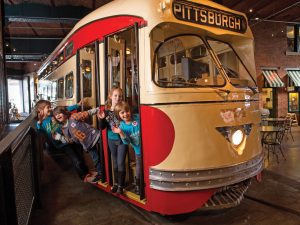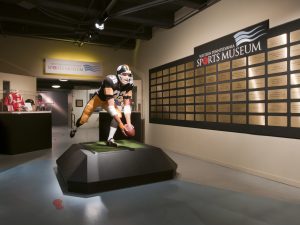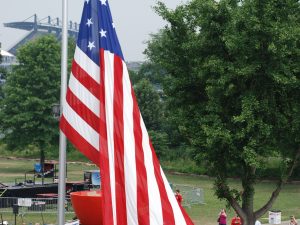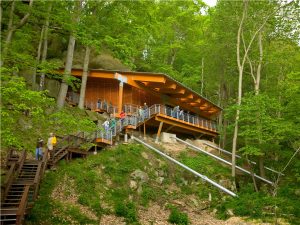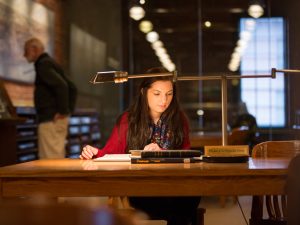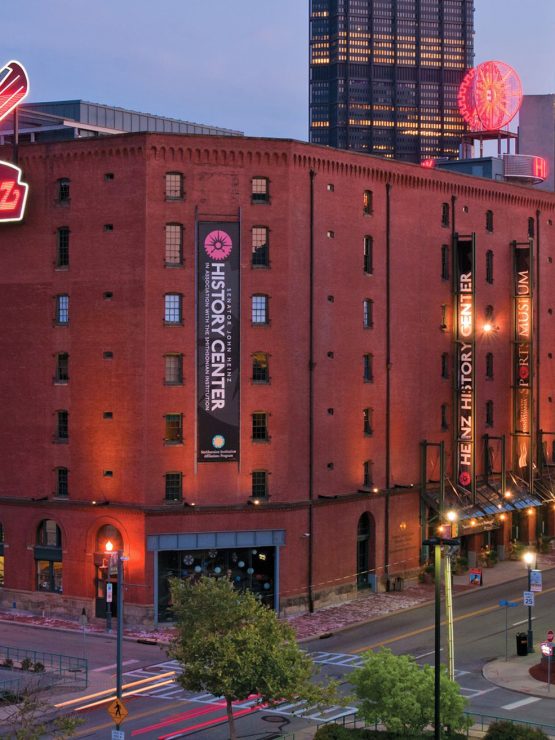
About the Heinz History Center
The Senator John Heinz History Center is Pennsylvania’s largest history museum and a proud affiliate of the Smithsonian Institution. Devoted to the history and heritage of Western Pennsylvania, our family of museums includes the Heinz History Center, Western Pennsylvania Sports Museum, Fort Pitt Museum, and Meadowcroft Rockshelter and Historic Village. The History Center is home to the Thomas & Katherine Detre Library & Archives.
Our mission is to engage and inspire large and diverse audiences through programs that enable links to the past, understanding in the present, and guidance for the future by preserving regional history and presenting the American experience with a Western Pennsylvania connection.
This work is accomplished in partnership with others through archaeology, archives, artifact collections, broadcast and electronic media, civic engagement, conservation, educational programs, exhibitions, events, library, museums, public outreach, performance, preservation, publications, products, research, technical assistance, and virtual programs.
Our Story
The Senator John Heinz History Center traces its roots back to 1879, making it the oldest cultural institution in Western Pennsylvania.
In 1879, the Old Residents of Pittsburgh and Western Pennsylvania established a historical society to help preserve local history. Five years later, the name changed to the Historical Society of Western Pennsylvania and has been in continuous existence for more than 135 years.
Originally, membership in the historical society was limited to men who had lived in the region for 50 years or more, though the rules changed within a few years to include women and younger people. In those days, members enjoyed lectures and country outings and got together to reminisce. Perhaps most importantly, early Historical Society members worked to preserve archival materials and objects of historic significance, forming the foundation of the History Center’s collections.
The Historical Society brought our region’s history to the public. In 1908, it celebrated the region’s 150th anniversary; in 1911, the centennial of steamboat navigation; in 1958, the region’s bicentennial celebration; and in 2008, the region’s 250th anniversary. These events served as the basis for the many events, publications, educational programs, and exhibitions that the History Center offers today.
Early meetings of the Historical Society were held in members’ homes and churches, though a significant step was taken in 1893 when the Carnegie Library of Pittsburgh at Schenley Park offered space for the archives. In 1914, after securing the funding, the Historical Society built its own building on Bigelow Blvd. In 1996, the History Center moved into its current home in Pittsburgh’s Strip District.
With the opening of the Smithsonian wing in 2004, the History Center became the largest history museum in Pennsylvania. The new wing allows better opportunities found in our affiliation with the Smithsonian Institution. The additional space added the Western Pennsylvania Sports Museum, the Mueller Education Center, the Special Collections Gallery, and the McGuinn Gallery for traveling exhibitions.
Since its opening, the Smithsonian wing has been home to various exhibitions, including Pennsylvania’s Civil War, Vatican Splendors, 1968: The Year that Rocked America, Pittsburgh’s Lost Steamboat: Treasures of the Arabia, We Can Do It! WWII, Toys of the ’50s, ’60s and ’70s, #Pixburgh: A Photographic Experience, Destination Moon: The Apollo 11 Mission.
In 2014, the History Center opened the new Museum Conservation Center, located directly behind the museum on Penn Avenue. The nine-story building houses the museum’s artifacts under one roof with Smithsonian-quality storage.
Heinz History Center
As Pittsburgh’s “people museum,” the History Center preserves and interprets the history of Western Pennsylvanians through six floors of interactive exhibitions that feature iconic artifacts like the TV set from “Mister Rogers’ Neighborhood” and the world’s oldest jeep.
Western Pennsylvania Sports Museum
The Western Pennsylvania Sports Museum, located on the History Center’s second and third floors, celebrates the unsurpassed sports legacy of the City of Champions. From football to baseball and hockey to golf, the Sports Museum highlights the region’s passion for amateur and professional sports.
Fort Pitt Museum
The Fort Pitt Museum, located in historic Point State Park in Downtown Pittsburgh, is a two-floor, 12,000-square-foot museum that presents the story of Western Pennsylvania’s essential role during the French & Indian War, the American Revolution, and as the birthplace of Pittsburgh.
Meadowcroft Rockshelter and Historic Village
Meadowcroft Rockshelter and Historic Village, the oldest site of human habitation in North America, is located in Avella, Washington County, Pa. Meadowcroft Rockshelter, a National Historic Landmark, features 19,000-year-old evidence of the region’s earliest inhabitants under a massive rock overhang. In addition to the Rockshelter, the site is also home to three outdoor historic areas, including a 16th century Indian village, 18th century Frontier Trading Post, and 19th century village that help visitors experience life over the past 500 years.
Detre Library & Archives
More than 250 years of our region’s history can be found at the Thomas and Katherine Detre Library & Archives. Founded in 1879, the Library & Archives’ collections are accessible to researchers, students, and the general public.
Financial Information
The History Center recently earned the coveted 4-star rating from Charity Navigator for sound fiscal management and commitment to accountability and transparency, so you can be confident that your donation is going to a great place.

